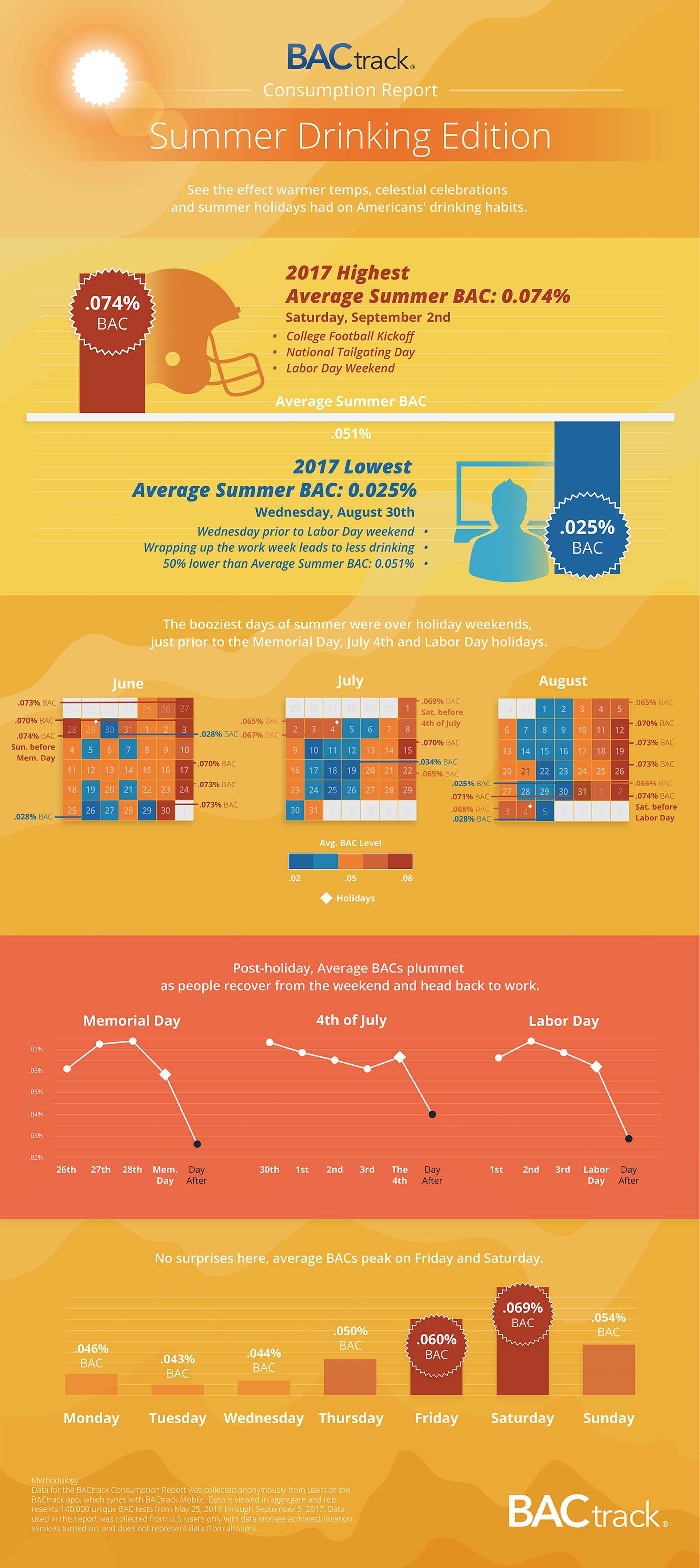2017 Summer Drinking Data
See the effects warmer temps and summer holidays have upon Americans' drinking habits
In our latest Consumption Report, we analyze average BAC (Blood Alcohol Content) levels across the U.S. this past Summer.
Read on and check out some of our past reports looking at average BAC levels for NFL fans and average BAC levels by state and by major U.S. holidays.
The Booziest Days of Summer
- The booziest day of the entire summer was the Saturday before Labor Day, September 2nd, with an average BAC of 0.074%. This is also the college football kickoff and National Tailgating Day (no wonder!).
- The average BAC is just under the legal limit of 0.08% BAC and it’s 45% higher than the summer average of 0.051%.
- Three of the top five days with the highest average BAC are over holiday weekends, just prior to the holiday. While the Saturday before Labor Day has an average BAC of 0.074%, each of the other days in the top five has an average BAC of 0.073%.
- September 2nd, the Saturday before Labor Day: 0.074%
- May 28, the Sunday before Memorial Day: 0.073%
- June 30, the Friday before July 4th: 0.073%
- Saturday, August 19th: 0.073%
- Saturday, June 24th: 0.073%
- Almost half of the top 20 highest average BAC days were holidays or those days leading up to them. These include the Friday, Saturday, and Sunday before Memorial Day, July 4th, and Labor Day holidays.
…and the Most Sober Days of Summer
- Post-holiday, average BACs plummet; they’re also lower prior to holiday weekends.
- The lowest average BACs are nearly 50% less than the summer average of 0.051%.
- Wednesday, August 30th had the lowest average BAC of the entire summer (0.025% BAC).
- Our best guess: people are doing whatever they can to wrap things up prior to the long Labor Day weekend and the official end of summer. They are too busy for drinking!
- Other days with the lowest average BAC are as follows:
- Tuesday, May 30, the day after Memorial Day: 0.026%
- Tuesday, September 5, the day after Labor Day: 0.028%
- June 29, the Thursday before July 4th weekend: 0.028%
- Wednesday, July 19th: 0.034%
Consistency is Key
- Although daily average BACs range from 0.074% to 0.025%, the monthly average BAC level for June, July and August is the same for each month at .051%
Working for the (Summer) Weekend
- Not surprisingly, Fridays (0.060%) and Saturdays (0.069%) have the highest average BACs.
- Summer days with the lowest average BACs are Tuesdays and Wednesdays; average BACs are 0.043% and 0.044% BAC, respectively.
Previous BACtrack Consumption Reports
Methodology
As always, the purpose of our BACtrack Consumption Reports is to provide insight into alcohol consumption patterns to encourage people to consider the effects of alcohol and make smarter decisions.
Data for this BACtrack Consumption Report was collected anonymously from users of the BACtrack app and which syncs with BACtrack Mobile and BACtrack Vio smartphone breathalyzers. Data is viewed in aggregate and represents unique BAC tests from May 25, 2017 to September 5, 2017. Data used in this report was collected from U.S. users only with data storage activated, location services turned on, and does not represent data from all users.
- Media inquiries, contact media@bactrack.com or Stacey Sachs at stacey.sachs@bactrack.com or 415/425-8324.
- BACtrack sales, contact sales@bactrack.com
- Developers interested in our API or SDK, contact developer@bactrack.com or visit sdk.bactrack.com
- Researchers interested in data collaboration, contact info@bactrack.com.
- Or call us toll-free at 877.334.6876.
How a BACtrack Works
When alcohol is consumed, it is absorbed from the mouth, throat, stomach, and intestines into the bloodstream.
As blood flows through the lungs, alcohol in the bloodstream moves across the membranes of the lung’s air sacs (alveoli) into the air. The concentration of the alcohol in the alveolar air is directly related to the concentration of the alcohol in the blood. As the alveolar air is exhaled, the alcohol in it can be detected by the breath alcohol testing device.
BACtrack Mobile and BACtrack Vio Smartphone Breathalyzers
All data in this study was collected from BACtrack Mobile, BACtrack's award-winning smartphone breathalyzer with police-grade Xtend®Fuel Cell Sensor Technology, and BACtrack Vio. When a user blows into BACtrack Mobile or BACtrack Vio, BAC results are wirelessly transmitted via Bluetooth® to an iOS or Android device, including Apple Watch. With the free BACtrack companion app, a user can get more than a simple BAC result -- they can track, save and share BAC results, attach a note or photo to a result, and with BACtrack's ZeroLine® feature, get an estimate of when their BAC will return to 0.00%.
About BACtrack
San Francisco‐based BACtrack is the #1 selling breathalyzer in North America, offering a full range of innovative products for both personal and professional use. Founded in 2001, BACtrack helps people monitor their blood alcohol content and make informed decisions about alcohol consumption. BACtrack has won Popular Science's 'Best of What's New' Award for its innovation in health, a Good Design award for best in category for consumer electronics, and has been named the top breathalyzer brand by Car & Driver. In 2016, BACtrack created the first wearable Alcohol Monitor, BACtrack Skyn, which won the NIH 'Wearable Alcohol Biosensor Challenge.' BACtrack products have been featured in USA Today, The New York Times, WIRED, Fast Company and other national and international publications. BACtrack breathalyzers are available in 20 countries and at over 15,000 store locations including Walgreens, Costco, Best Buy, Target, Rite Aid, and Pep Boys. BACtrack products can also be purchased online at BACtrack.com, Amazon, Walmart.com and Target.com. Connect with BACtrack via Twitter and on Facebook. For more company information, explore our site, www.bactrack.com.




